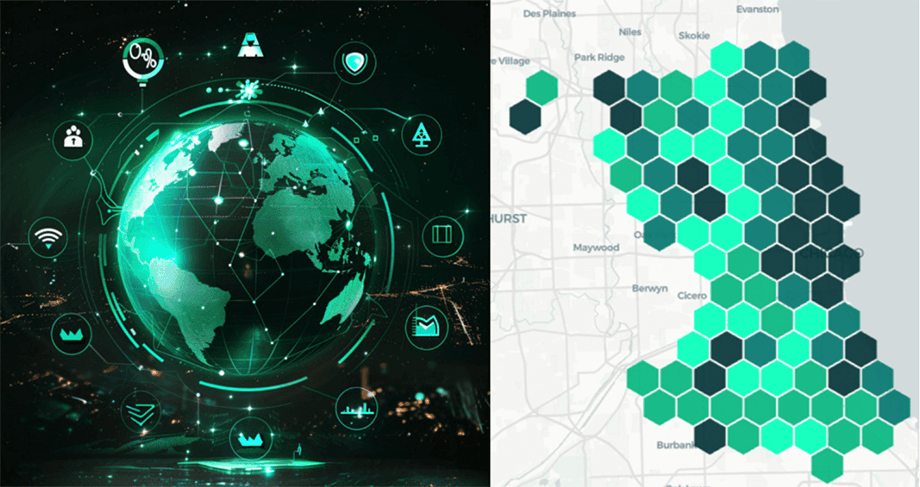Mapping the Invisible: A Look at the Power of Spatial Data
By XYZ.
3/18/22
What is Spatial Data?
Spatial data can be likened to tracking the journey of a ping pong ball within a cube. Each millisecond of its movement corresponds to a specific coordinate or location within that cube. As the ball bounces around, these coordinates continuously update, capturing the dynamic nature of its position with time.
As this environment expands to Earth, the concept evolves into geospatial data, the cube becomes a representation of our planet, and the coordinates transform into latitude and longitude and maybe even altitude.( xyz cartesian of the earth instead of the cube)
Just like the ping pong ball, every object on earth is associated to some spatial component
-“ Everyone or Everything is Somewhere “
But as we look deeper into the nuances of spatial, we realize that the nature of this data varies depending on industry, use case and source. For instance:-

Dynamic Nature (Spatio-Temporal)
Within the context of Logistics industry, the "ping pong ball" metaphorically represents each individual vehicle within a company's fleet. These vehicles act as dynamic entities moving within the spatial environment, which consists of road networks, traffic conditions, and various geographical features. Just as the ping pong ball moves within the cube, vehicles navigate through the spatial environment, with their positions (coordinates) continually updating as they travel along their routes.

Static Nature
Given a map of a local area, one indicates the location of their office with a point. This point serves as spatial data as it denotes the exact position of their office on the Earth's surface. Further, a map of the city that shows the locations of parks, schools, and roads, the positions of these features on the map don't change often, if at all. This is an example of static spatial data because it remains the same over time in terms of where these objects are located on the map.

Combination of Different Layers (spatial, attribute, temporal)
A real estate company may leverage a mix of traditional business data such as property sales figures, rental rates, and market trends (attribute data), alongside spatial data like population density, demographics, and land use zoning to identify optimal locations for new developments and understand market demand. Furthermore, they may tap into weather patterns and seasonal changes to enable them to predict fluctuations in property demand, assess climate-related risks, and tailor marketing or pricing strategies accordingly.(temporal data)
In this section, we will delve into two scenarios that demonstrate how spatial data is more prevalent in common use cases than we may realize.
Scenario 1 - Omnipresence of Spatial
Imagine you have a map of your neighborhood. On this map, you mark the location of your house with a dot. That dot represents spatial data because it shows the exact position of your house on the Earth's surface.
Now, let's say you add some additional information to this map. You label your house with its street address, the number of bedrooms it has, and whether it has a garden or not. This additional information represents attribute data because it describes characteristics of your house.
Additionally, let's suppose you use a GPS device to track the path you take as well as the duration when walking around your neighborhood. The device records your movements & time and stores them as a series of coordinates & timeframe. This data represents GPS & temporal data because it gives precise location as well as time component information obtained from the GPS receiver.
Scenario 2 - Bringing in a New Perspective to Businesses
Imagine you're running a retail company, and you're eager to optimize your store locations and operations. You want to start by gathering various types of data to inform your decisions.
Most companies only use traditional business data conditioned to store level insights like sales figures, inventory levels, and other product performance metrics.
However, what if you could gain access to customer demographics that can reveal which types of customers are more inclined to purchase specific products or brands, their purchasing patterns, and enable targeted marketing strategies based on customer segmentation.(attribute data)
Geotagged social media reviews and news articles reveal customer interests, emerging trends and opportunities for moment marketing (text data)
Further, you can broaden your scope by incorporating additional data sources. You can look at mobility data from mobile phones or vehicle telematics to understand traffic density and movement patterns in different areas.
You analyze satellite imagery to assess the surrounding environment and identify potential competitors or logistical challenges. (spatial data)
You can also tap into weather data to anticipate how seasonal changes or local climate patterns might affect sales. (temporal data)
Leveraging a combination like the one above can help pinpoint peak hours of activity within these populations and places, aiding in strategic business planning and resource allocation.
It gives you the context of the outside world to optimize your upcoming store locations instead of solely making decisions on store level data.
